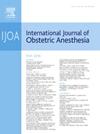评估非洲和亚洲产科安全麻醉教育培训后的行为影响和行为改变
IF 2.3
3区 医学
Q2 ANESTHESIOLOGY
引用次数: 0
摘要
背景:低收入和中等收入国家需要持续的产科麻醉专业发展,以降低孕产妇和新生儿的死亡率和发病率。为满足这一需求,开发了产科安全麻醉教育(SAFE)培训课程,已向40个国家的3,355多名医疗保健提供者提供了课程。培训课程对行为影响和行为改变的影响尚不清楚。该研究旨在评估安全产科培训课程在非洲和亚洲四个新地点(坦桑尼亚、津巴布韦、尼泊尔和孟加拉国)对行为和行为影响的影响。方法和结果通过三个不同时间点的问卷调查和技能评估,探讨了参与者的知识、技能和行为影响(对能力、机会和动机的看法);基线、训练后和随访(3-9个月)。一部分参与者在他们自己的工作场所进行跟踪观察,使用结构化的检查表来评估行为的任何变化。361名参与者完成了行为影响评估,在课程结束后,知识和技能都得到了改善,并且在随访中保持了改善。其他的行为影响并没有随着时间的推移而改变。78名参与者按照SAFE标准完成行为的情况差异很大,从进行充气呼吸的10%到实施脊髓麻醉前测量血压的96%不等。结论本课程有提高能力的疗效。然而,为了得出关于行为影响和行为改变的结论,需要提供更多的资源用于可靠的数据收集。本文章由计算机程序翻译,如有差异,请以英文原文为准。
Assessing behavioural influences and behavioural changes following Safer Anaesthesia From Education (SAFE) Obstetrics training in Africa and Asia
Background
There is a need for continuing professional development in obstetric anaesthesia in low- and middle-income countries to reduce maternal and newborn mortality and morbidity. The Safer Anaesthesia From Education (SAFE) Obstetrics training course was developed to meet this need and has been delivered to over 3,355 healthcare providers in 40 countries. The impact the training course has on behavioural influences and behaviour change is not known. The study aimed to evaluate the impact on behaviour and behavioural influences following the SAFE Obstetric training course in four new locations across Africa and Asia (Tanzania, Zimbabwe, Nepal and Bangladesh).
Methods and results
Participants knowledge, skills and behavioural influences (perceptions of capability, opportunity and motivation) were explored via a questionnaire and skills assessments at three different time points; baseline, post-training and at follow-up (3–9 months). A subset of participants were observed in their own workplace at follow-up using a structured checklist to assess any changes in behaviour. Three-hundred and sixty-one participants completed the behavioural influences assessments, knowledge and skills both improved after the course and improvements were maintained at follow-up. Other behavioural influences did not show change over time. Completion of behaviours in a subset of 78 participants to SAFE standards varied widely, ranging from 10% for performing inflation breaths to 96% for measuring blood pressure before administering spinal anaesthetic.
Conclusions
There is evidence of efficacy of the course to increase capabilities. However, for conclusions to be drawn about behavioural influences and behaviour change, more resources need to be made available for robust data collection.
求助全文
通过发布文献求助,成功后即可免费获取论文全文。
去求助
来源期刊
CiteScore
4.70
自引率
7.10%
发文量
285
审稿时长
58 days
期刊介绍:
The International Journal of Obstetric Anesthesia is the only journal publishing original articles devoted exclusively to obstetric anesthesia and bringing together all three of its principal components; anesthesia care for operative delivery and the perioperative period, pain relief in labour and care of the critically ill obstetric patient.
• Original research (both clinical and laboratory), short reports and case reports will be considered.
• The journal also publishes invited review articles and debates on topical and controversial subjects in the area of obstetric anesthesia.
• Articles on related topics such as perinatal physiology and pharmacology and all subjects of importance to obstetric anaesthetists/anesthesiologists are also welcome.
The journal is peer-reviewed by international experts. Scholarship is stressed to include the focus on discovery, application of knowledge across fields, and informing the medical community. Through the peer-review process, we hope to attest to the quality of scholarships and guide the Journal to extend and transform knowledge in this important and expanding area.

 求助内容:
求助内容: 应助结果提醒方式:
应助结果提醒方式:


